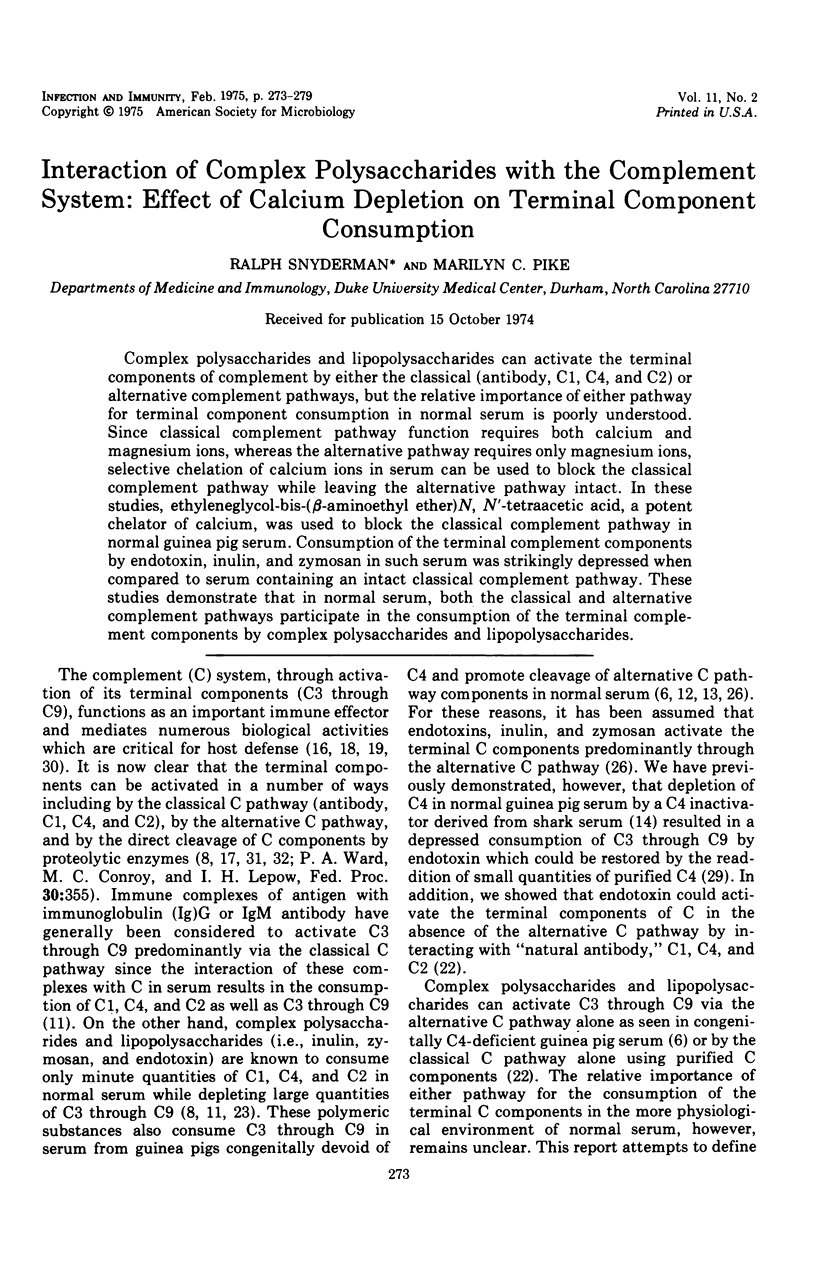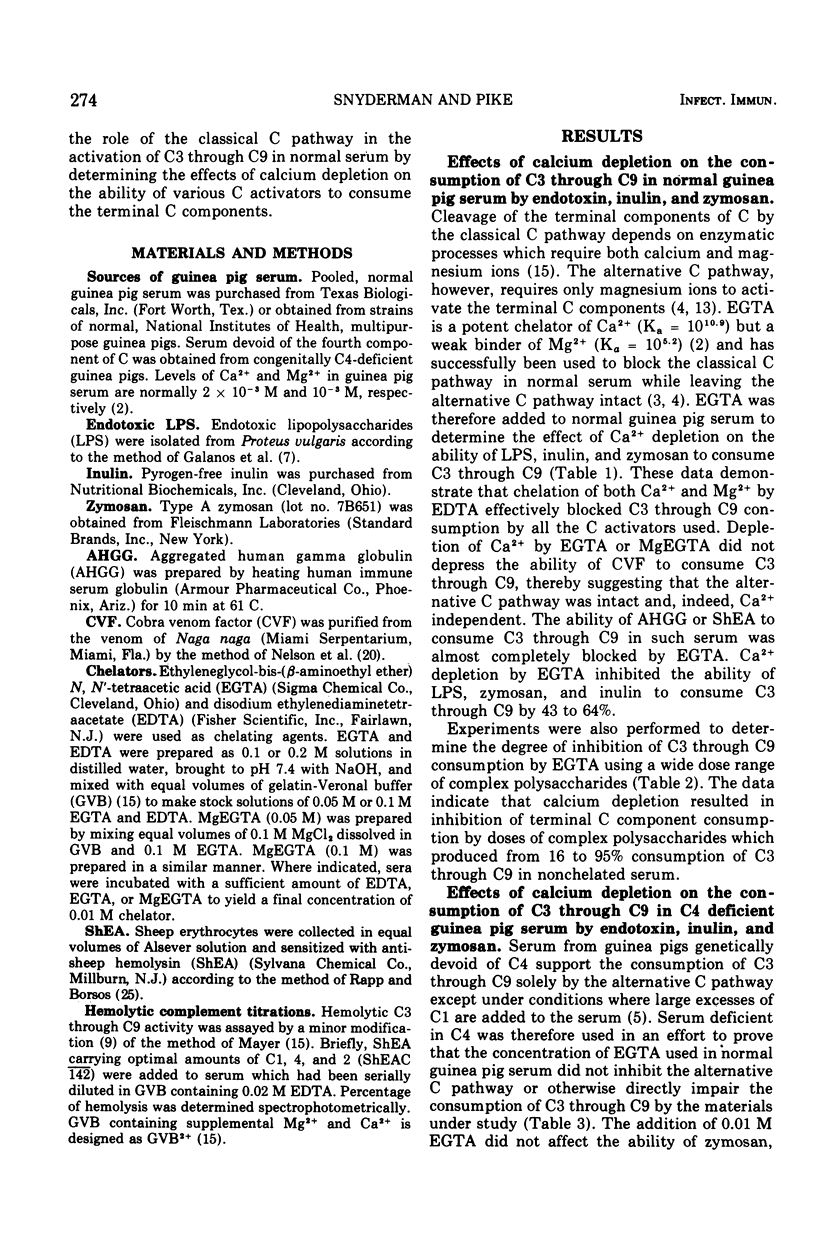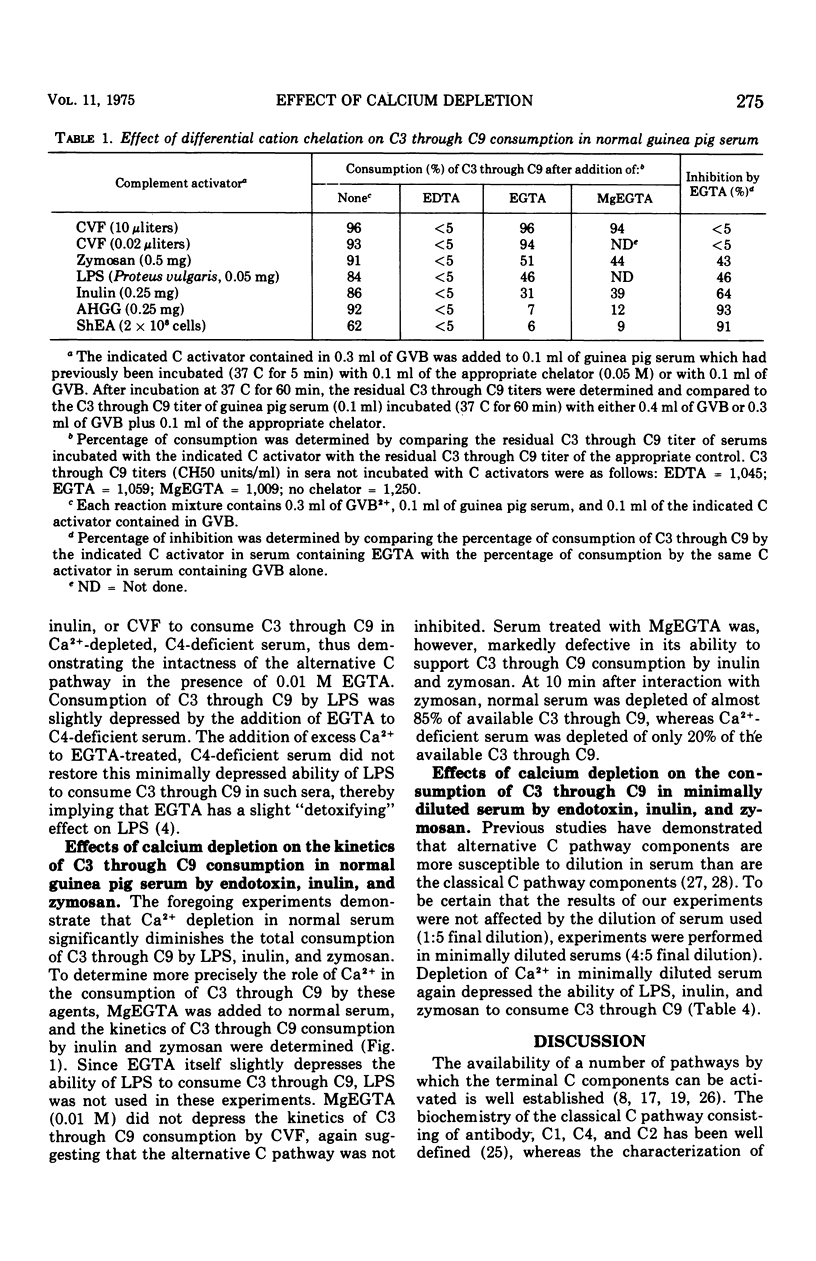Abstract
Complex polysaccharides and lipopolysaccharides can activate the terminal components of complement by either the classical (antibody, C1, C4, and C2) or alternative complement pathways, but the relative importance of either pathway for terminal component consumption in normal serum is poorly understood. Since classical complement pathway function requires both calcium and magnesium ions, whereas the alternative pathway requires only magnesium ions, selective chelation of calcium ions in serum can be used to block the classical complement pathway while leaving the alternative pathway intact. In these studies, ethyleneglycol-bis-(beta-aminoethyl ether)N, N-tetraacetic acid, a potent chelator or calcium, was used to block the classical complement pathway in normal guinea pig serum.Consumption of the terminal complement components by endotoxin, inulin, and zymosan in such serum was strikingly depressed when compared to serum containing an intact classical complement pathway. These studies demonstrate that in normal serum, both the classical and alternative complement pathways participate in the consumption of the terminal complement components by complex polysaccharides and lipopolysaccharides.
Full text
PDF






Selected References
These references are in PubMed. This may not be the complete list of references from this article.
- Brade V., Lee G. D., Nicholson A., Shin H. S., Mayer M. M. The reaction of zymosan with the properdin system in normal and C4-deficienct guinea pig serum. Demonstration of C3- and C5-cleaving multi-unit enzymes, both containing factor B, and acceleration of their formation by the classical complement pathway. J Immunol. 1973 Nov;111(5):1389–1400. [PubMed] [Google Scholar]
- Bryant R. E., Jenkins D. E., Jr Calcium requirements for complement dependent hemolytic reactions. J Immunol. 1968 Oct;101(4):664–668. [PubMed] [Google Scholar]
- Fine D. P. Activation of the classic and alternate complement pathways by endotoxin. J Immunol. 1974 Feb;112(2):763–769. [PubMed] [Google Scholar]
- Fine D. P., Marney S. R., Jr, Colley D. G., Sergent J. S., Des Prez R. M. C3 shunt activation in human serum chelated with EGTA. J Immunol. 1972 Oct;109(4):807–809. [PubMed] [Google Scholar]
- Frank M. M., May J., Gaither T., Ellman L. In vitro studies of complement function in sera of C4-deficient guinea pigs. J Exp Med. 1971 Jul 1;134(1):176–187. doi: 10.1084/jem.134.1.176. [DOI] [PMC free article] [PubMed] [Google Scholar]
- Galanos C., Lüderitz O., Westphal O. A new method for the extraction of R lipopolysaccharides. Eur J Biochem. 1969 Jun;9(2):245–249. doi: 10.1111/j.1432-1033.1969.tb00601.x. [DOI] [PubMed] [Google Scholar]
- Gewurz H., Page A. R., Pickering R. J., Good R. A. Complement activity and inflammatory neutrophil exudation in man. Studies in patients with glomerulonephritis, essential hypocomplementemia and agammaglobulinemia. Int Arch Allergy Appl Immunol. 1967;32(1):64–90. doi: 10.1159/000229917. [DOI] [PubMed] [Google Scholar]
- Gewurz H., Shin H. S., Mergenhagen S. E. Interactions of the complement system with endotoxic lipopolysaccharide: consumption of each of the six terminal complement components. J Exp Med. 1968 Nov 1;128(5):1049–1057. doi: 10.1084/jem.128.5.1049. [DOI] [PMC free article] [PubMed] [Google Scholar]
- Goodkofsky I., Lepow I. H. Functional relationship of factor B in the properdin system to C3 proactivator of human serum. J Immunol. 1971 Oct;107(4):1200–1204. [PubMed] [Google Scholar]
- Jensen J. A. A specific inactivator of mammalian C'4 isolated from nurse shark (Ginglymostoma cirratum) serum. J Exp Med. 1969 Aug 1;130(2):217–241. doi: 10.1084/jem.130.2.217. [DOI] [PMC free article] [PubMed] [Google Scholar]
- Mayer M. M. Highlights of complement research during the past twenty-five years. Immunochemistry. 1970 May;7(5):485–496. doi: 10.1016/0019-2791(70)90231-4. [DOI] [PubMed] [Google Scholar]
- Mayer M. M. The complement system. Sci Am. 1973 Nov;229(5):54–66. doi: 10.1038/scientificamerican1173-54. [DOI] [PubMed] [Google Scholar]
- Mergenhagen S. E., Snyderman R., Gewurz H., Shin H. S. Significance of complement to the mechanism of action of endotoxin. Curr Top Microbiol Immunol. 1969;50:37–77. doi: 10.1007/978-3-642-46169-9_2. [DOI] [PubMed] [Google Scholar]
- Müller-Eberhard H. J. Chemistry and reaction mechanisms of complement. Adv Immunol. 1968;8:1–80. doi: 10.1016/s0065-2776(08)60464-2. [DOI] [PubMed] [Google Scholar]
- Nelson R. A., Jr A new concept of immunosuppression in hypersensitivity reactions and in transplantation immunity. Surv Ophthalmol. 1966 Aug;11(4):498–505. [PubMed] [Google Scholar]
- Nicholson A., Brade V., Lee G. D., Shin H. S., Mayer M. M. Kinetic studies of the formation of the properdin system enzymes on zymosan: evidence that nascent C3b controls the rate of assembly. J Immunol. 1974 Mar;112(3):1115–1123. [PubMed] [Google Scholar]
- PILLEMER L., BLUM L., LEPOW I. H., ROSS O. A., TODD E. W., WARDLAW A. C. The properdin system and immunity. I. Demonstration and isolation of a new serum protein, properdin, and its role in immune phenomena. Science. 1954 Aug 20;120(3112):279–285. doi: 10.1126/science.120.3112.279. [DOI] [PubMed] [Google Scholar]
- Phillips J. K., Snyderman R., Mergenhagen S. E. Activation of complement by endotoxin: a role for 2 globulin, C1, C4 and C2 in the consumption of terminal complement components by endotoxin-coated erythrocytes. J Immunol. 1972 Aug;109(2):334–341. [PubMed] [Google Scholar]
- Ruddy S., Gigli I., Austen K. F. The complement system of man. I. N Engl J Med. 1972 Sep 7;287(10):489–495. doi: 10.1056/NEJM197209072871005. [DOI] [PubMed] [Google Scholar]
- Sandberg A. L., Osler A. G. Dual pathways of complement interaction with guinea pig immunoglobulins. J Immunol. 1971 Nov;107(5):1268–1273. [PubMed] [Google Scholar]
- Sandberg A. L., Snyderman R., Frank M. M., Osler A. G. Production of chemotactic activity by guinea pig immunoglobulins following activation of the C3 complement shunt pathway. J Immunol. 1972 May;108(5):1227–1231. [PubMed] [Google Scholar]
- Snyderman R., Gewurz H., Mergenhagen S. E., Jensen J. Effect of C4 depletion on the utilization of the terminal components of guinea-pig complement by endotoxin. Nat New Biol. 1971 Jun 2;231(22):152–154. doi: 10.1038/newbio231152a0. [DOI] [PubMed] [Google Scholar]
- Snyderman R., Phillips J. K., Mergenhagen S. E. Biological activity of complement in vivo. Role of C5 in the accumulation of polymorphonuclear leukocytes in inflammatory exudates. J Exp Med. 1971 Nov 1;134(5):1131–1143. doi: 10.1084/jem.134.5.1131. [DOI] [PMC free article] [PubMed] [Google Scholar]
- Snyderman R., Shin H., Dannenberg A. M., Jr Macrophage proteinase and inflammation: the production of chemotactic activity from the fifth complement by macrophage proteinase. J Immunol. 1972 Oct;109(4):896–898. [PubMed] [Google Scholar]
- West C. D., Winter S., Forristal J., Davis N. C. Effect of ageing of serum on consumption of antibody by beta-1C-globulin determinants; evidence for circulating breakdown products in glomerulonephritis. Clin Exp Immunol. 1968 Jan;3(1):57–62. [PMC free article] [PubMed] [Google Scholar]


